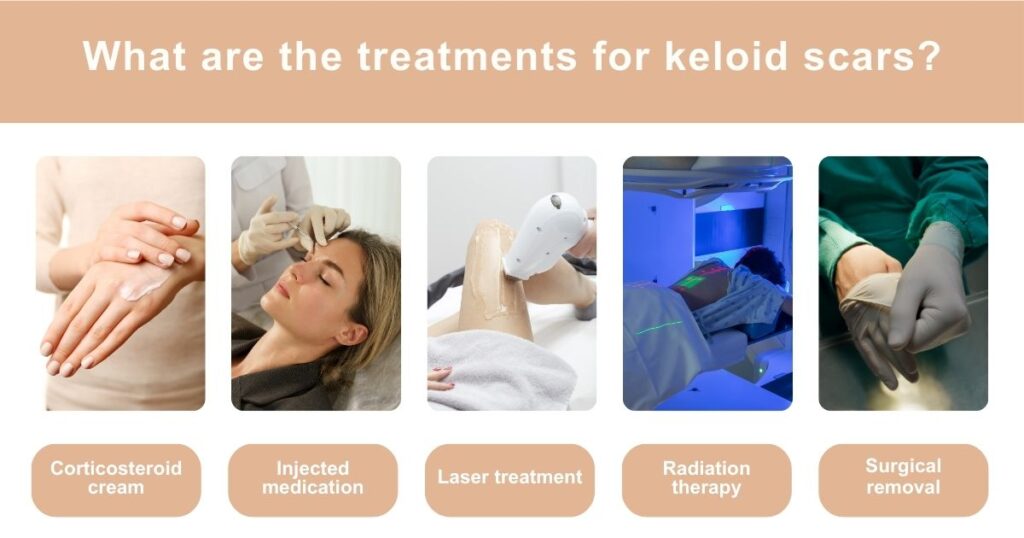Keloid scars can be a real bother. They’re more than just minor imperfections on your skin; they can itch and even be uncomfortable. However, there’s no need to fret! Knowing how to heal keloid scars can be truly transformative. Let’s look at some of the Keloid treatment options in Dubai.
What Are The Key Strategies To Fast Heal Keloid Scars?
Before we discuss the healing strategies, we must know what keloid scars are. These are thick, puckered scars that extend beyond the original wound’s borders. They form when the body produces excessive collagen during the healing process.
Dubai’s Keloid Management is a special way doctors in dubai treat skin bumps called keloids to make them smaller and less noticeable.
- Gentle Massages : A gentle massage can increase blood flow and reduce collagen buildup.
- Silicone Sheets : Silicone sheets or gels can help to flatten keloid scars.
- Sun Protection: Protect your scars from the sun to avoid darkening and further skin damage.
- Topical Retinoids: These can reduce the size and height of early keloid scars.
- Medical Creams: Topical creams or ointments prescribed by a doctor can help.
- Steroid Injections: If the keloid scar persists, your doctor might suggest steroid injections.
- Cryotherapy: This process uses extreme cold to shrink keloids.
- Laser Therapy : Professional laser therapy can reduce scar tissue and lighten the scar’s colour.
- Surgery: Sometimes, removing the scar surgically is the best option.
- Radiation Therapy : After surgery, this can prevent the keloid from returning.
- Pressure Therapy: Wearing a pressure garment can compress the scar, leading to flattening over time.
- Lifestyle Changes : A balanced diet and adequate hydration can support skin health and healing.
- Avoid Piercing and Tattoos : These can trigger new keloid scars.
- Regular Exercise : Physical activity improves overall blood flow, supporting skin healing.
- Mental Wellbeing : Stress can impact your body’s healing process. Practice mindfulness or other stress management techniques.
What Key Factors Influencing Keloid Healing?
Understanding the factors that influence the healing of keloid scars can aid in their effective management. These include the following factors Scar Removal via Cryotherapy Synopsis is a process where doctors use extreme cold to remove scars. It’s like using ice to erase a mark on your skin! Preventing Keloid Formation: Key Steps for Smooth Skin is about stopping bumpy scars from forming and keeping your skin smooth. It teaches you how to take care of your skin to avoid these scars.
Removing facial keloids means getting rid of thick, raised scars on your face to make your skin look smoother. Keloid facial treatment helps to reduce or remove thick, raised scars on the face, making the skin look smoother. Keloid removal Dubai price can range from 500 to 3000 AED depending on the size and number of keloids.
Book A Consultation With Dr Shehzadi Tasneem
Top-rated Plastic Surgeon For Keloid in Dubai
Installment Plan Available
Nose piercing keloid treatment includes using special creams or getting small injections to make the bump go away. Keloid Scar Pain Alleviation can be helped by using special creams or getting treatments from a doctor to make the pain go away
Keloid Scar Removal: Natural Restoration helps your skin heal and look better using natural methods like oils and creams Keloid removal techniques include surgery laser treatments and steroid injections These methods help reduce or eliminate raised scars on the skin
Keloid triggers postoperative Wounds from surgery can sometimes cause keloids to form especially in people who are prone to them these raised scars may appear weeks or months after the operation Avoid keloid formation by keeping wounds clean and protected Use silicone sheets or pressure dressings to
Budget-friendly scar solutions can help improve the appearance of scars without spending a lot of money You can try natural remedies like aloe vera or coconut oil for Local keloid specialists are doctors who focus on treating raised scars called keloids These experts help people manage and reduce keloid scars using different treatments
Keloid scar treatments can include special creams or injections to shrink the scar Doctors may also use surgery or laser therapy to remove or reduce Keloid revision techniques Doctors use special methods to make big scars smaller and less noticeable these methods are called
Keloid aspirin research looks at how aspirin might help stop keloids from growing Scientists study if aspirin can make keloid scars smaller or prevent them from forming Keloid treatment results
- Genetics: Some individuals are genetically predisposed to forming keloid scars. If your parents or grandparents had them, you might be more likely to develop them too.
- Skin Type : Those with darker skin are more prone to developing keloid scars, though anyone can get them.
- Age : Keloids are more common in younger individuals, especially those under 30.
- Location of the Injury: Keloid scars are more likely to form in areas of the body where the skin is taut, such as the chest, shoulders, earlobes, and upper back.
- Severity of the Injury: The worse the initial injury, the more likely a keloid scar will form.
- Infection: If a wound becomes infected, it can delay healing and potentially lead to keloid formation.
- Wound Care: How you care for a wound can significantly affect the healing process. Proper wound care can reduce the risk of keloid formation.
- Nutrition : A balanced diet rich in vitamins and minerals supports skin health and can help the healing process.
- Sun Exposure: Keloid scars can darken if exposed to the sun. This can delay healing and make the scar more noticeable.
In-Depth Look at Treatments: How to Heal Keloid Scars

Keloid scars can be a source of discomfort and may affect one’s confidence. These are thick, overstretched scars that extend beyond the original wound. They arise when the body overproduces collagen during the healing process.
- Corticosteroid Cream: A prescription-strength corticosteroid cream can help alleviate itchiness associated with keloid scars.
- Injected Medication: If you have a smaller keloid, your doctor might suggest reducing its thickness by injecting it with cortisone or other steroids. This generally requires monthly injections for up to six months. Potential side effects include skin thinning, the appearance of spider veins, and permanent skin colour change.
- Laser Treatment : Larger keloids can be flattened using pulsed-dye laser treatment, which has also proven beneficial in reducing itchiness and fading keloid scars. The therapy is delivered over multiple sessions, with 4 to 8 weeks between each. Side effects, more common in those with darker skin, can include changes in skin colour, blistering, and crusting.
- Radiation Therapy : Low-level X-ray radiation, either on its own or post-surgery, can help shrink or reduce scar tissue. Repeat treatments may be required. Possible side effects include skin complications and, in the long term, an increased risk of cancer.
- Surgical Remova l: If your keloid hasn’t responded to other therapies, your doctor may recommend surgical keloid scar removal in combination with other methods. Note that surgery alone has a recurrence rate of 45% to 100%.
Learn more about the keloid scar ear surgery
Understanding how to heal keloid scars fast can bring hope and pave the path to recovery. It’s essential to consider each treatment’s potential benefits, risks, and the possibility of recurrence. Always consult with a healthcare professional to determine the best course of action for your unique circumstances.
And remember, despite the challenges that keloid scars may present, their appearance can be significantly improved with the right care and treatment. Ready to take the first step towards healing? Dr Shehzadi is here to guide you. Book a consultation now and start your journey to keloid scar recovery.












